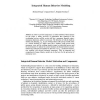ICONFERENCE
2011
13 years 5 months ago
2011
An annotator’s classification of a text not only tells us something about the intent of the text’s author, it also tells us something about the annotator’s standpoint. To un...
SPEECH
2011
13 years 8 months ago
2011
Intelligibility predictors tell us a great deal about human speech perception, in particular which acoustic factors strongly effect human behavior, and which do not. A particular...
ICPR
2010
IEEE
14 years 2 months ago
2010
IEEE
Recent advances in pattern recognition has allowed computer scientists and psychologists to jointly address automatic analysis of of human behavior via computers. The Workshop on H...
FLAIRS
2004
14 years 3 months ago
2004
Modeling human behavior can be complicated and expensive. To be able to reduce costs, new methodologies and tools must be developed that automate the creation of human behavior mo...
MVA
2007
14 years 3 months ago
2007
This paper presents a recognition method for human behavior identification based on motion history image theory. The motion history image has the advantage that it can record the ...
DAGSTUHL
2007
14 years 3 months ago
2007
In order to prevent emergencies or critical situations where humans are the origin, a timely provision of information thus obtained for the coordinating services and the on-site st...
ATAL
2008
Springer
14 years 3 months ago
2008
Springer
As increasing numbers of processors and agents pervade the human environment, societies comprising both humans and agents will emerge. Presently, it is unknown how a person might ...
AIIDE
2008
14 years 4 months ago
2008
Culture and emotions have a profound impact on human behavior. Consequently, high-fidelity simulated interactive environments (e.g., trainers and computer games) that involve virt...
DIGRA
2003
Springer
14 years 7 months ago
2003
Springer
Interpretation of characters is a fundamental feature of human behavior. Even with limited information available, people will assign personality – even to inanimate objects. Cha...
GECCO
2004
Springer
14 years 7 months ago
2004
Springer
To create a realistic environment, some simulations require simulated agents with human behavior pattern. Creating such agents with realistic behavior can be a tedious and time con...




